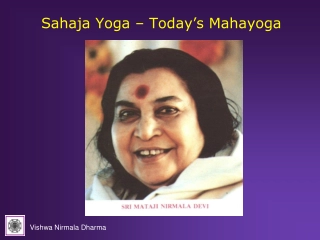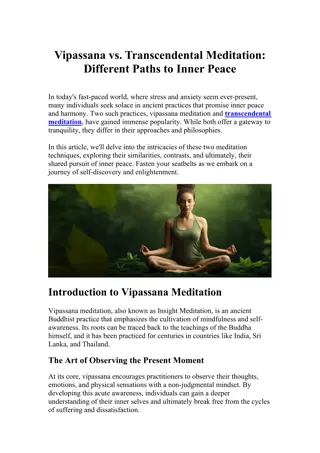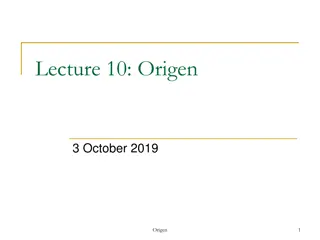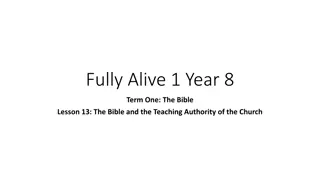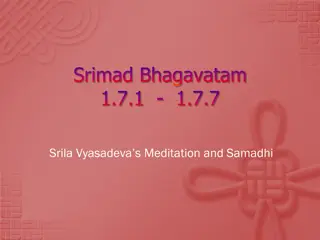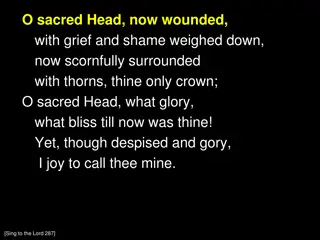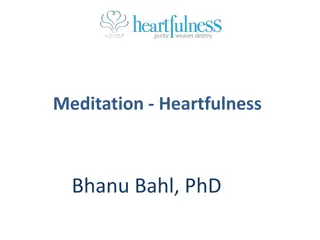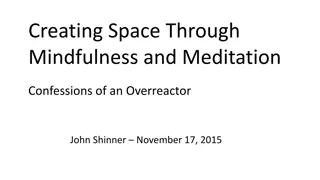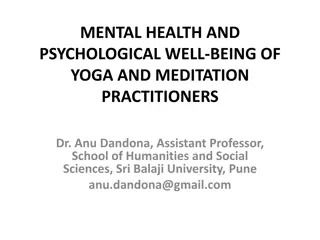Exploring Lectio Divina: Ancient Meditation on Sacred Scripture
Lectio Divina, an ancient form of meditation on sacred scripture, leads one to prayer by allowing the Word of God to resonate in the heart. Rooted in Monastic practice, it empowers individuals to live out the divine message, as exemplified by the Desert Fathers like St. Antony of Egypt. By listening to and responding to the Word of God, believers understand their calling to draw closer to God, find purpose, and share the message of love and hope with others.
Download Presentation

Please find below an Image/Link to download the presentation.
The content on the website is provided AS IS for your information and personal use only. It may not be sold, licensed, or shared on other websites without obtaining consent from the author. Download presentation by click this link. If you encounter any issues during the download, it is possible that the publisher has removed the file from their server.
E N D
Presentation Transcript
TERM 1, 2021 Session 4 Prayer: Lectio Divina and Visio Divina Principles and Procedures Presented by: Christopher Neaves Education Officer, Church Engagement Mission and Identity Directorate Sydney Catholic Schools
Introductory Prayer Lord our God, your Son Jesus Christ is to us the way that leads to you and to one another, the truth that is Good News of love and hope, the life which he sacrificed to give it. Help us to show the way to him and to go his way to one another, to speak the truth that is encouraging and credible, to give life by sharing his divine Word. Through Christ Jesus our Lord Amen
Lectio Divina (Latin for divine reading)is an ancient form of meditation on sacred scripture where one reads slowly through a text until a word or phrase attracts the reader and moves the heart to prayer. Lectio Divina represents the Word of God itself as opposed to a human activity on the Word of God. (Kylie Cullen: Lectio Divina Transforming from Within, Inform 146) As the Desert Fathers would explain Lectio Divina was teaching' and the texts of scripture transmitting this teaching. One should listen attentively to lectio divina, that God in lectio divina reminds us of how we should live. (Armand Veilleux, Lectio Divina as a school of prayer among the Fathers of the Desert)
The Second Vatican Council described the study of the sacred pages as the very soul of sacred theology. (Dei Verbum, Dogmatic Constitution on Divine Revelation 1965 #24) In reading the sacred texts we discover in both the Jewish texts and the Christian texts how the Word of God confronted the hearer and at the same time initiated a response from the hearer. We find this in Jeremiah 1:5 and Mark 3:13. The twelve disciples respond to the power of the Word by answering the call of Jesus to follow me. This radical change in the direction of the lives of the prophets and later the disciples was a witness to the power of the Word of God and allowed for an effective means to proclaim the divine message to others.
Therefore, by listening to the voice of God communicated to the hearer in responding to the Word of God we like the disciples and the prophets understand the purpose of our calling, to drawer closer to God and Jesus and proclaim this Word to others in a way that will bring meaning and purpose to their life. St Athanasius describes how the life of St Antony of Egypt was to be dramatically transformed through listening to the Word of God in Matthew 19:21and responding to it as a personal calling. Lectio Divina is founded in Monastic practice and is part of traditional Christian spirituality. The Desert Fathers like St Antony found that the Word of God became their life. Prayer was to become the very way of life for the Desert Fathers. So, for the Desert Fathers sacred Scripture was not something to be read but lived as a way of life as one in constant dialogue with God.
Lectio Divina was both a way of life and a way of prayer. It developed into a method (a process) for them, when you pray, you speak to God, when you read, God speaks to you. (Armand Veilleux, Lectio Divina as a school of prayer among the Fathers of the Desert) The methodical structure of Lectio Divina can be found in the work of a Carthusian monk, Guigo II (1140-1193). He elaborated on St. Benedict s practice of Lectio Divina from the 6th Century. The Carthusians are a contemplative, ascetic religious order of monks, nuns and brothers founded in the early 12th century by St Bruno of Cologne. One of Guigo s most famous spiritual works is the Scala Claustralium (The Ladder of Monks) or the Scala Paradisi (The Ladder to Paradise). Guigo draws on Jacob s vision in Genesis 28:12 of angels ascending and descending the ladder to God, bringing human prayers to heaven and God s answers to earth.He writes, When I was hard at work one day, thinking on the spiritual work needful for God s servants, four such spiritual works came to my mind, these being: lectio, meditatio, oratio and contemplatio. You don t have to be a monk to climb the ladder of monks that stretch up into the heavens! His words set the table with the manna from heaven that we all hunger for! (Guigo II. The Ladder of Monks and Twelve Meditations. Trans. Edmund Colledge, O.S.A. and James Walsh, S.J. Kalamazoo: Cistercian Publications, Inc., 1978, p. 68-69. [Cisterician Studies #48)
In the practice of Lectio Divina we can speak of the Four Rs: Reading (lectio), Reflecting (meditation), Responding (oratio), Resting (contemplation) Reading (lectio): sit quietly, read slowly and allow God s word to dwell within your heart and mind. Read a short passage from sacred Scripture, Lectio Divina is about depth not breadth. Read the same passage at least three times. Pause after each reading for periods of silence allowing for the Holy Spirit to open your heart and mind to God s Word. You are listening for words or phrases that resonate within your heart. If in a group prayer allow for each to speak aloud, without comment the word or phrase that speaks to you. Reflecting (meditation): engage your intellect, seeking to understand what God might be saying to you in the passage. Read a short Biblical commentary on the passage. What does it make you think about? What is the passage saying to you? How is the passage connected to your life? Let the life of the Word give you life. let the word of Christ dwell in you richly (Col. 3:16) Resonding (oratio): ask yourself what is the message here for me? Ponder your answer, talk to God, ask what it is He wants of you. In responding it is your turn to speak to God
Resonding (oratio): ask yourself what is the message here for me? Ponder your answer, talk to God, ask what it is He wants of you. In reading God has spoken to you and then you have reflected on the message. In responding it is your turn to speak to God. Draw into conversation with God about the passage, what does it make you want to pray for? Do you want to thank God, praise God, seek forgiveness, complain to Him, ask for His help, petition Him, seek His blessing. Prayer is the cry of the heart. Prayer is tears. Prayer is joy. Prayer is asking. Prayer is offering. Prayer is the gift you give to God. Allow yourself to be changed by God s Word. Resting (contemplation): simply rest quietly in the presence of the One who loves you. Sometimes this message will stay in your heart or mind for some time. Pray the word, carry the word with you, live out the word. Allow God s Word to penetrate your very being, to transform and influence your life. Prayer should accompany the reading of God s Word, so that a dialogue takes place between God and man. For we speak to him when we pray; we listen to him when we read the divine oracles. (Dei Verbum #25) The question in your heart during Lectio Divina is not, Is God speaking to me? but rather What is God saying to me?
Action (action): this is a fifth stage of the exercise and it refers to you being moved and transformed by the Word of God into what you have received as a hearer to now become a giver of the Word of God to others. You are now a disciple and apostle of God s Word to the world; your Christian calling, to be faith in action in the world.
Visio Divina is divine vision or divine seeing. Here the prayer scans the picture, icon or image in a similar way as Lectio Divina.
Visio Divina is a slow prayerful examination of a work of art as a tool for raising your heart and mind to dialogue with God. Gaze at the image and use it as an inspiration to pray. Follow the stages of Lectio Divina
Prepare: close your eyes, breathe, clear your mind Lectio (read): Open your eyes and read/scan the image. Slowly examine the contents, look for details, notice what stands out to you but continue to read/scan the whole image. Work to understand the meaning or story told by the image. Close your eyes a minute. Meditatio(meditate): Meditate on the image. Open your eyes and let your eyes be lead. Connect to what you know about the background of the image. Focus on just this part of the image and name it. Imagineyourself present in the events. Consider expression, colour, symbolism. Close your eyes, seeing that part of the image in your mind. Oratio(pray): Open your eyes and look again at that part of the image that caught your eye. Pray with the image. Dialogue with God about what you see in the image and what you think. Ask God to reveal what He wants you to understand through the image. Allow it to bring forth a word, image, or emotion. Close and rest your eyes.
Contemplatio: (contemplation): Open your eyes and gaze at the image. Contemplate the image. Quietly examine the image again. What is God speaking to you today through this image? Note what God taught you through your prayer with this piece of art. Meanwhile, standing near the cross of Jesus were his mother, and his mother s sister Mary, the wife of Clopas, and Mary of Magdala. When Jesus saw his mother and the disciple whom he loved standing beside her, he said to his mother, Woman, here is your son. Then he said to the disciple, Here is your mother. And from that hour the disciple took her into his own home. (John 19: 25 John 19: 25- -27) 27) What might God be whispering to your heart at this moment? How does Mary s example speak to me? Encourage me? Challenge me?



